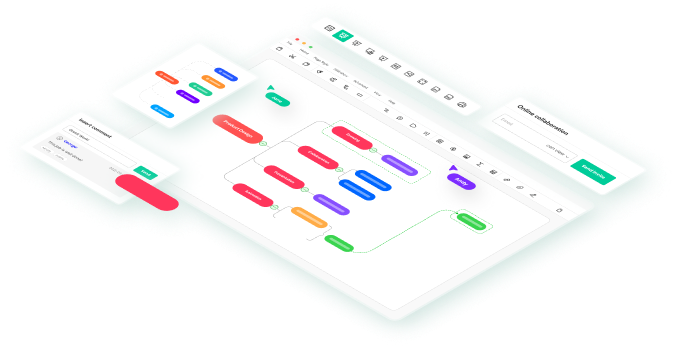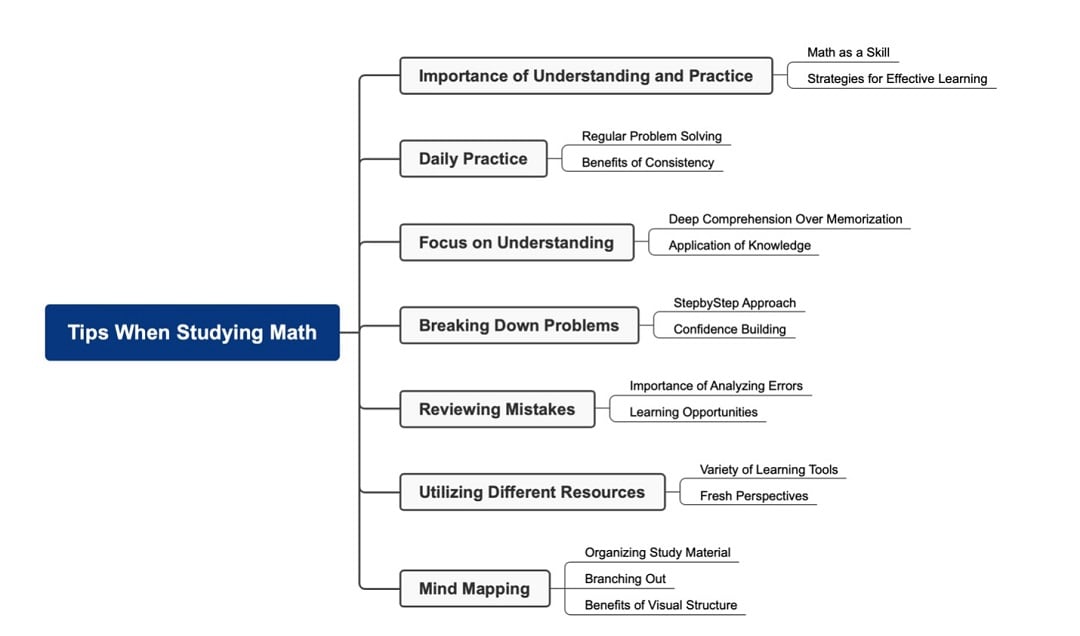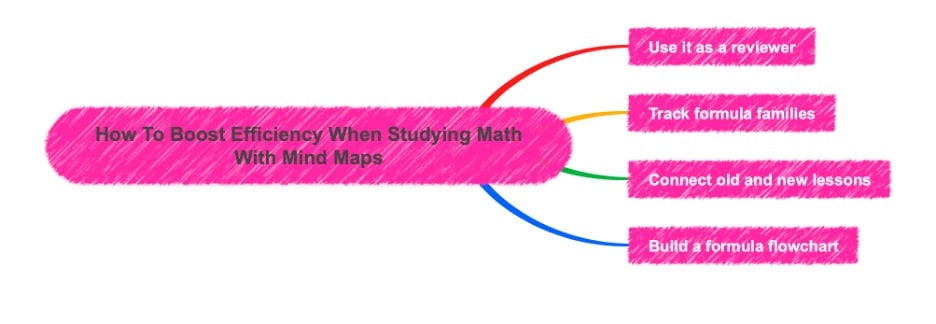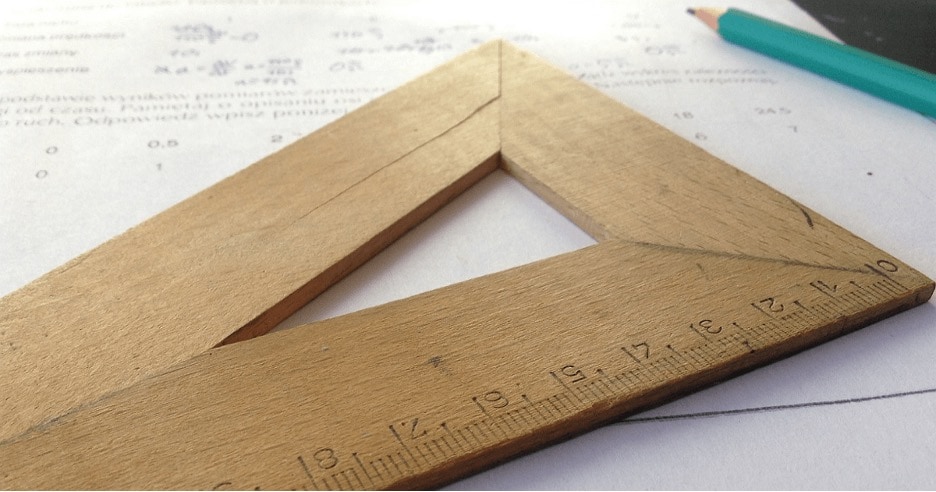
Even if you are new to mind maps, math is a term you would definitely be aware of. The two terms can be brought together to make your learning experience extremely simple and fun.
That said, here you will learn what a mind map is all about and how it can help study math or any other subject, for that matter.
Mind mapping is a process used for brainstorming, such as designing a business strategy, investigating an error, defining an approach to achieve a specified target, or learning a complex concept or subject.
It is done via graphical illustrations, typically using a well-labeled diagram. A mind map comprises a box that represents the main topic of the plan or strategy.
This box can be further extended with several small boxes representing categories or parts, and even smaller boxes to denote subcategories, and so on.
It is easy to learn through diagrams because they require less brainpower to memorize compared to the traditional method of preparing text documents, notes, etc., and then reading and remembering them.
Therefore, the mind map approach for brainstorming is now being adopted by many organizations and educational institutions.
In this article
How Mind Maps Help Study Math
Mind maps are pretty helpful in academics, and math is no exception. With mind maps, math can be easy to understand. Below are a couple of ways mind maps can be useful in studying mathematics:
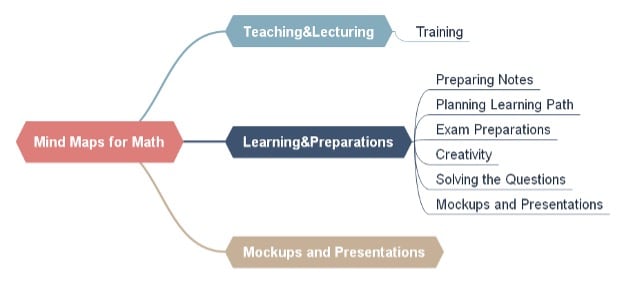
For Teaching and Lecturing
From the teachers' perspective, mind maps offer flexibility and benefits in teaching math, making the course great fun.
As it could be tedious to dictate notes to the students and wait for the weakest one to write what you have dictated, educating them about mind maps and their benefits once helps the scholars take down the notes comparatively faster.
As a result, the pace of your training and their learning could be remarkably increased.
If you wish to learn more about teaching mind maps and want to access some mind map templates for teachers, please check out our elaborated guide on mind map ideas for teachers.
For Learning and Preparations
This section discusses six aspects in which mind maps aid in studying math for learning and preparation.
Preparing Notes
While studying, it could be a bit challenging to listen to the lecturer and jot down the notes word-for-word. Not because doing so is complicated, but because it consumes more time.
An easier approach could be to use lines and rectangles, labeling them accordingly instead. These shapes can be drawn quickly using any efficient mind mapping solution like EdrawMind, and labeling them with the proper names would be less tedious.
Planning Learning Path
Mathematics can be overwhelming at times due to all the alien names and equations the syllabus is populated with. Therefore, it can sometimes be daunting to decide which chapter to study first and how to study it.
With mind maps, you can draw a diagrammatic timetable for yourself that would contain a sequential list of the lessons you should learn and practice.
Exam Preparations
This is somehow the result of a proactive approach that helps you during your exam time.
If you have used mind maps to prepare notes while studying math, revising the lessons and chapters at the time of examinations would be extremely easy and fun.
This is something you won't enjoy if you have followed the text notes approach during the class lectures.
Being Creative
Although math equations can be solved using some particular formulas and principles, the way of writing notes still varies from student to student.
The case is similar to mind maps. The approach you take to create your mind map may differ from that drawn by your class fellow.
This makes you more creative and helps you diagnose the problems thoroughly. This further enables you to solve the questions quickly and easily.
Solving the Questions
Solving a math question requires several steps, and a complex problem could be solved in multiple phases where, in some cases, each phase needs you to apply a different formula.
Since the entire process could be quite confusing, mind maps prove to be a savior in a way that you can draw a diagram illustrating the number of phases involved in the solution.

If you wish to learn more about student mind maps and want to access some mind map templates for students, check out our elaborated guide on mind map ideas for students, where you will find several EdrawMind-created mind maps for students.
For Mockups and Presentations
Many institutions practice the concept of mockups and presentations where a student is supposed to act as a trainer and deliver lectures to their students.
With mind maps, math lectures can be convenient for conveying information, easy to explain, and fun to participate in. This approach is way more engaging than the traditional, old-school methods that have been followed to date.
To summarize, with mind maps, math training and learning could be great fun, easy to understand, and hard to forget.
While traditional approaches are useful and help students gain knowledge, mind maps are less time-consuming and make the entire topic more entertaining, despite their complexities.
If you are wondering how to use mind maps for presentations, check out our elaborated guide on mind map templates for presentations, where you will get access to several previously created mind map templates.
How To Use Mind Maps for Studying Math
Now that you have seen the importance of creating a math mind map, let us show you the easiest way to make a mind map on your computer.
To do this, you will need to download and install EdrawMind according to your operating system.
If you plan to have a remote collaboration with your team, head to Wondershare Edrawmind and log in to the system using your registered email address.
Once you have launched this mind mapping tool, you can start working on your math mind map.
Step 1: Add Main Topic
The first step after launching EdrawMind is to decide whether you are going ahead with pre-built templates or creating a unique math mind map.
If you are planning to make one from scratch, head to the 'New' option on the left, which takes you directly to the canvas board.
By default, EdrawMind comes with a mind map layout that has one main topic and three subtopics.
As per your math mind map requirement, you can modify the content of the main topic and move on to the subsequent subtopics.
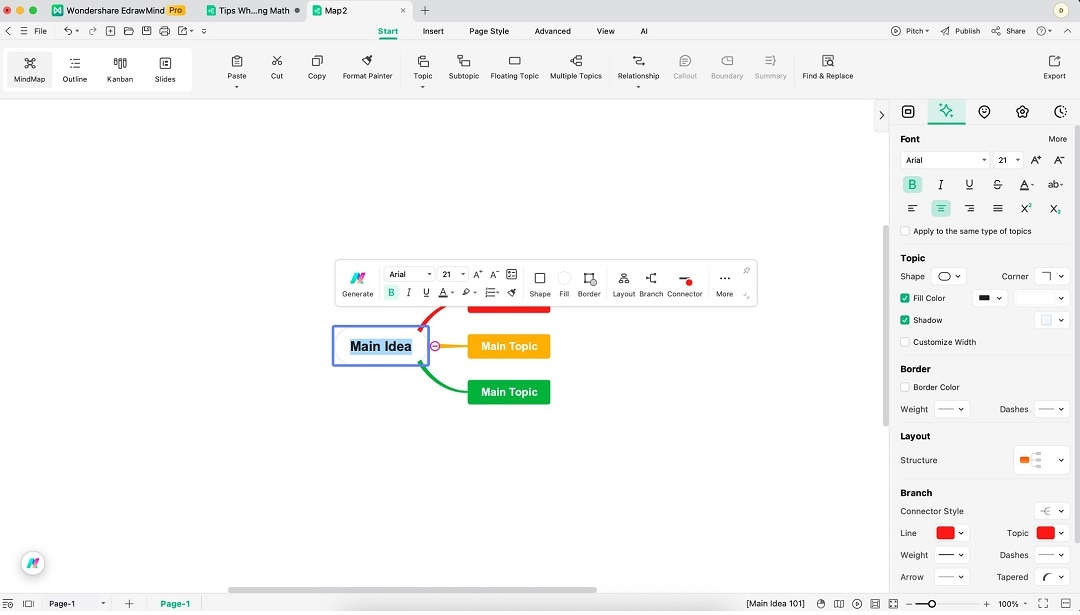
Step 2: Add Branches
Once you have renamed or modified the central theme, you can start adding multiple sub-branches to it. In EdrawMind, you can add various sub-branches depending on the complexities of your main topic.
You can have hundreds of different branches of any given subtopic. With EdrawMind, you can even go ahead and create connections between different branches if you find them relevant.

Step 3: Customize
With EdrawMind, you can easily customize your mind maps by changing the layouts, updating the theme, connector's style, colors, and more.
At EdrawMind, you will also find a feature dedicated to mathematical formulas, which ensures that your math mind map is technically correct.
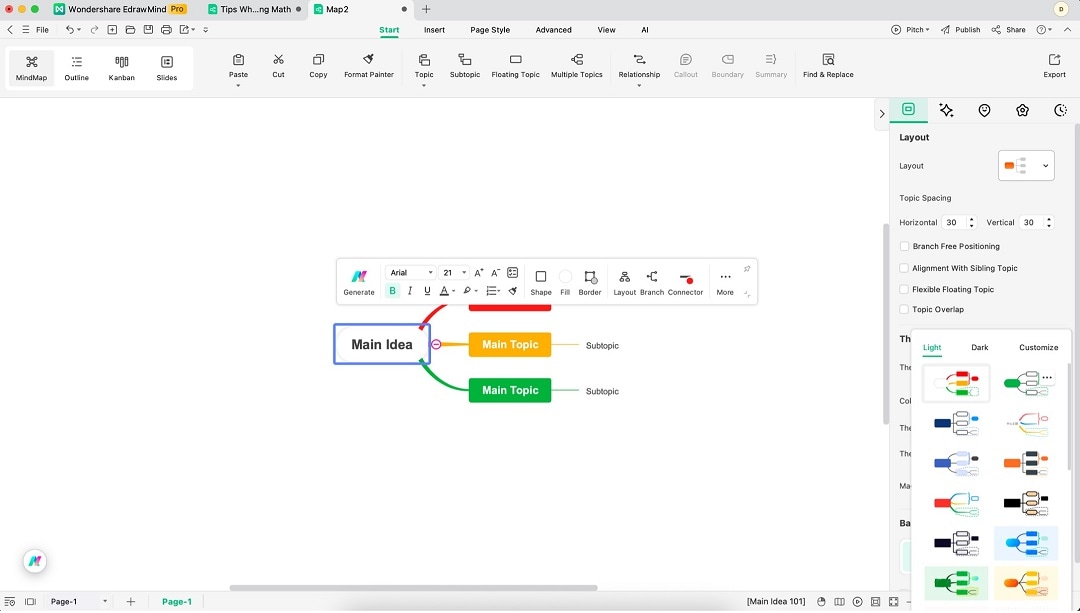
Step 4: Export & Share
Once you are satisfied with your math mind map, you can share it among your peers or teachers using the built-in share option.
EdrawMind lets you export the math mind map in multiple formats, like JPEG, PNG, SVG, PDF, HTML, and other Microsoft formats, like Word, Excel, and PowerPoint.
In addition, you can share your math mind map on several social media platforms, like Facebook, Twitter, Pinterest, and Line.

Tips When Studying Math
Math is a subject that requires both understanding and practice. Memorizing formulas is not enough; you need strategies that help you see patterns, solve problems step by step, and review effectively.
Below are some tips to guide you as you study math.
Practice Every Day
Math is a skill, and like any skill, it improves with repetition. Spend time solving problems daily, even if only a few. Regular practice builds familiarity with formulas and methods, making them easier to recall during exams.
For example, working on a set of algebra problems each evening keeps concepts fresh.
Focus on Understanding, Not Memorization
Instead of memorizing solutions, focus on understanding why a formula or method works. For instance, when studying the Pythagorean theorem, learn how it applies to different triangles rather than just recalling the equation.
This deeper approach makes it easier to apply knowledge to new problems.
Break Problems Into Steps
Complex math questions can feel overwhelming. Break them down into smaller parts. Start by identifying what is being asked, then write out the known information, and finally choose the formula or method to use.
This step-by-step process reduces mistakes and builds confidence.
Review Mistakes Carefully
Do not skip over errors. Go back and analyze where you went wrong. If you miscalculated a fraction, review fraction rules before moving on.
Treat every mistake as a learning opportunity, since it shows you the exact areas that need attention.
Use Different Resources
Sometimes a textbook explanation is not enough. Use video tutorials, practice worksheets, or math forums to see different approaches to the same topic. A fresh perspective can make a difficult concept much easier to understand.
Use Mind Maps
For the whole article, mind mapping is the way to go. So, as the last tip, use a mind map to organize your math study.
Place the main topic, such as “Calculus,” at the center, and branch out into formulas, theorems, and example problems. Add colors and images to highlight key areas.
This visual structure makes complex topics easier to break down and remember, especially when revising before exams.
How To Boost Efficiency When Studying Math With Mind Maps
Now, you can take a look at how you can use it to boost efficiency. When an exam is coming up, you’ll need speed, and mind mapping can give you that.
- Use it as a reviewer. Under each node, add formulas, examples, and quick notes. This way, you can bring your printed mind maps to school as a reviewer.
- Track formula families. Group formulas by topic (e.g., Area and Perimeter, Quadratic Equations, Trigonometric Ratios). This helps you see patterns and avoid mixing them up during tests.
- Connect old and new lessons. Math topics aren’t solo topics you should study separately. As you proceed through your syllabus, relate each math topic accordingly.
- Build a formula flowchart. Turn formulas that depend on each other into a connected map. It trains you to think logically and remember relationships.
When using mind maps, it’s best to use digital tools like EdrawMind. Aside from its obvious mind mapping features, templates, and elements, it has AI features like an AI chatbot that can help you better understand the content.
It’s better to use digital tools because using the traditional pen and paper can be limiting. Math is a vast subject, so you’ll need EdrawMind’s infinite canvas for the purpose of studying.
Resource Recommendations for Math Study
Having the right resources can make studying math far more effective. Below are some options you can rely on:

For Guides
Start with open-source math guides such as Paul’s Online Math Notes (free and detailed for algebra, calculus, and differential equations). The Khan Academy Math Library is also excellent for structured lessons, videos, and practice problems.
For Tests and Practice
Download past papers or problem sets to mimic exam conditions. The Art of Problem Solving (AoPS) platform offers challenging practice, while IXL Math provides adaptive exercises tailored to your level.s
For standardized test practice, GMAT or SAT math prep books include structured problem sets with explanations.
For Quick References (PDFs)
Many universities publish free math handouts. Examples include MIT OpenCourseWare’s math lecture notes and summary sheets, or UC Davis’s Calculus Summary PDFs. These can be downloaded and kept as revision companions.
Key Takeaways
Often students have a hard time grasping the concepts of math, including the theorems and formulas.
However, with math mind maps, math training and learning could not only be fun but also ensure that the student is gaining the correct knowledge.
Since mind mapping takes less time to make, a teacher can use this learning methodology to explore different math-related topics. These examples show that you can also create wonderful math mind maps using EdrawMind.
EdrawMind is a mind mapping tool designed to help students and teachers. With EdrawMind, you can create education-related mind maps using amazing templates that are fully customizable.
The tool has 22 structures that help create timelines, org charts, lists, and more.
With over 33 well-designed themes, you can easily modify your math mind map that you can later share on social media platforms like Facebook, Pinterest, Twitter, and Line.
In addition, EdrawMind comes with templates ranging from business, life, personal, education, health, and more. So, you do not have to worry about creating any mind map from scratch.
Download EdrawMind today and start creating math mind maps as per your requirements.
If you are a teacher who is conducting home tuitions, check out EdrawMind Online, from where you can remotely collaborate with your students, with whom you can work on several mind maps.
FAQs
As our parting gift, here are some frequently asked questions, the answers to which you’d greatly appreciate as you study math:
-
1. How much time should I spend studying math each day?
It depends on your level and goals, but consistency matters more than hours. Even 30–45 minutes daily can be more effective than cramming for several hours once a week.
For advanced courses, extend sessions to one to two hours with breaks.
-
2. Why do I forget formulas so quickly?
Forgetting usually happens when you only memorize instead of applying. To retain formulas, solve varied problems that use them in different contexts.
For example, practice quadratic equations in word problems, graphing, and algebraic manipulation. Repetition in multiple forms helps the formula stick.
-
3. What should I do if I keep making the same mistakes?
Stop and analyze the error closely. Check if it’s a calculation slip, a misunderstanding of a concept, or a misreading of the question.
Write the correct process next to the mistake so you can review it later. Keeping an “error log” is a proven way to track and fix recurring issues.
-
4. Can I study math effectively without a tutor?
Yes. Many students succeed with self-study, provided they use the right resources. Online tutorials, problem sets, and interactive tools can replace or supplement a tutor.
However, if you consistently struggle with certain topics, seeking help from a teacher or study group can save time.
-
5. How can I make revising math less overwhelming before exams?
Break revision into smaller chunks. Focus on one topic per session—such as geometry in the morning, algebra in the evening. Use summary sheets or mind maps to condense large chapters into quick overviews.
Visual tools help you recall concepts faster and reduce stress during final review.



